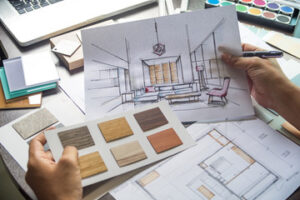Interior Designers Utah are experts at planning spaces that promote the wellbeing of those who occupy them. Their design skills are essential in a range of different settings, from healthcare and education to commercial and residential spaces. 
They work with clients to create design schemes that meet their needs, take into account airflow, heat, extraction, electrical, and plumbing regulations, and comply with health and safety legislation. They also act as project managers throughout the construction process by providing instructions to contractors, tradesmen, and fit-out specialists.
Space planning is one of the most important skills for interior designers to develop. It allows them to create spaces that are both attractive and functional. It also helps them make sure that their clients are happy with their work.
A well-planned space flows smoothly from one area to the next and offers a sense of cohesion and unity of form and function. This is especially true for areas that have a lot of activity, like kitchens, bedrooms, and office workstations.
Without space planning, these rooms can feel cramped and awkward, and it can be difficult for people to get from one room to another without having to navigate multiple pathways or obstructions. Over time, these issues can turn into regrettable design mistakes that affect a client’s enjoyment of their home.
In addition to addressing these functional deficiencies, space planning considers the psychological needs of the people who will use the space. For example, a bathroom or bedroom that is used by someone with mobility problems will need to be designed in a way that makes it easy for them to get around and take care of routine activities.
Space planning also involves making sure that furniture and accessories are placed in ways that allow natural light to flow into a room. This is particularly important if the client wants to achieve a suffused and cozy vibe in their space.
Visualization is a critical part of interior design and has a significant impact on how designers work. It helps them accurately plan their projects and avoid costly mistakes or wrong choices. In addition, visualization allows people on their team and clients to make suggestions easily and quickly, ensuring that designs are completed on time and within budget.
The interior design profession has seen a huge increase in the use of 3D visualization in the last decade. This is largely because it’s easy, fast, and affordable to produce high-quality interior renders using modern software.
Moreover, visualization is an excellent way to showcase photorealistic interior designs to prospective clients. This can help interior designers attract more clients and build their brand.
It also makes it easier for clients to see how their new space will look before they’ve even begun construction. This means they can decide where to place furniture, experiment with colors, and visualize how their spaces will look after they’ve been decorated.
One of the biggest challenges in designing spaces is incorporating realistic lighting. However, visualization can show natural and artificial light, allowing for a more accurate representation of what the finished product will look like.
Furthermore, visualization helps ensure that all members of the team are on the same page with design goals and objectives. This is especially important during the early stages of a renovation or new-build project, when it’s crucial to get all parties on board with the design concept.
It’s also a great way for remote teams to collaborate on an idea. This is possible with modern visualization technologies, which allow users to send edits and requests for changes to each other instantly.
Budgeting is a must for any interior design project. Whether you are renovating your home, staging your property for sale, or just looking to update your space, a realistic budget will ensure you end up with a beautiful home that is within your means.
Many interior designers work on an hourly basis and bill their clients for their time spent on the project. However, it is often possible to negotiate a lower rate if you pay for the design services upfront or agree to make furniture purchases and other supplies at discounted prices with your designer.
Some interior designers also charge a flat fee for their work based on the size of your project. If you choose this option, it is important to discuss your budget and any potential alterations with the designer before you hire them.

